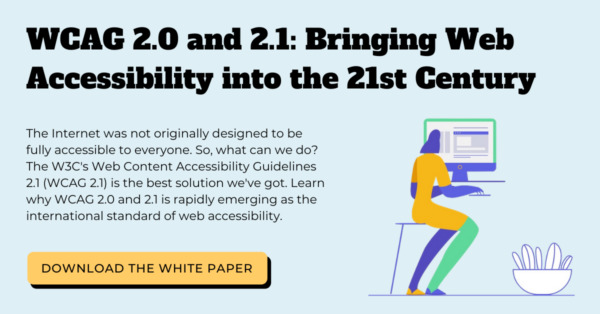The New WCAG 3 Draft: Here’s What You Should Know
Updated: August 30, 2023
Accessibility advocates everywhere are excited in anticipation of the release of WCAG 3. Although it’s currently an incomplete draft that will continue to develop over the next few years, it’s still a major occasion.
If you’re an avid member of the #a11y community online, then you’re probably very familiar with WCAG. If you’re new to the scene, WCAG stands for the Web Content Accessibility Guidelines. It’s one of the most prominent web and digital accessibility standards and is recognized internationally by numerous governments, policymakers, developers, content creators, and more.
No matter where you are on your journey, this draft offers great insight on how to improve digital accessibility for all. Let’s dive into the new WCAG 3 draft and some of the major takeaways.
WCAG 3 vs. WCAG 2
The most up-to-date version of WCAG is WCAG 2.1, an extension of WCAG 2.0 which is commonly referenced in major accessibility laws. When referencing standards for accessibility, this is the one to follow until WCAG 3 is complete.
Similar to the WCAG 2.x series, WCAG 3 will provide guidance and requirements on how to make the web and its contents (i.e. videos, apps, tools, etc.) more accessible to people with disabilities.
However, just like many other things in life, it’s important that WCAG evolves – especially considering how rapidly technology changes. The major goals of the new draft are to:
- Make it easier to comprehend 💡
- Include more user needs (i.e. people with cognitive disabilities) 🤝
- Offer flexibility to address various types of web content, apps, tools, and organizations 💪
With new goals comes new updates – including significant changes to the structure of WCAG 3.
From Success Criteria to Outcomes
In WCAG 2.x, success criteria are used to determine how well the contents of a webpage meet the guidelines. This is determined on a pass or fail basis. In other words, it’s either you fully meet the criteria or you don’t meet the criteria.
With the new draft, it’s no longer called success criteria; now they’re outcomes. Outcomes don’t follow the pass/fail model. Instead, they use a rating scale with scores between 0 (very poor) and 4 (excellent). The scores of each outcome are added together to determine the accessibility of a web page. The WCAG 3 draft allows for websites to have some issues while still being able to meet a level of conformance.
From Levels A, AA, and AAA to Bronze, Silver, and Gold
In the current version of WCAG, there are three levels of compliance to attain accessibility: levels A, AA, and AAA. Level A is the easiest to maintain, while Level AAA is the most comprehensive, highest accessibility standard. In Section 508 of the Rehabilitation Act, Level AA is what’s required by law.
The WCAG 3 draft is changing to new levels of conformance which are now Bronze, Silver, and Gold – Gold being the highest level. Although the current and new levels of conformance aren’t fully equivalent, the Bronze level is similar to WCAG 2.x Level AA. According to the draft,l a website must have a total score of 3.5 or higher to be in compliance with the Bronze level.
On the other hand, the Silver and Gold levels require what are known as “holistic tests” like assistive technologies and usability testing with users with disabilities.
From Non-Interference Requirements to Critical Errors
WCAG 2.x has what is known as non-interference requirements which are essentially “must-haves” in order for a website to be included in the scope of conformance. These requirements must be followed because they could interfere with how a user interacts with a web page.
Similarly, the new draft has updated this concept and it’s now called critical errors. If a website has any critical errors then it cannot meet WCAG 3 standards at any level.
Review the Full WCAG 3 Draft ➡️
What the New WCAG 3 Draft Means for Video Accessibility
As mentioned above, WCAG 3 is a working draft; it isn’t expected to be used as a guideline or referenced in laws any time soon so we’ll likely see more drafts before it’s published. As for now, it’s set to be published in 2023.
In this current draft, there are no new changes to the guidelines on video accessibility tools such as captions and audio description. Therefore, we’ll have to reference WCAG 2.0 and 2.1 in the meantime.
Overall, we’re hopeful to see new updates over the coming years and we’ll continue to monitor and update the blog post as the WCAG 3 draft develops.








